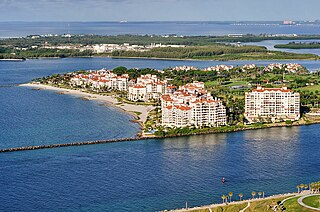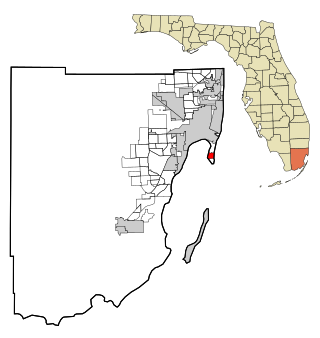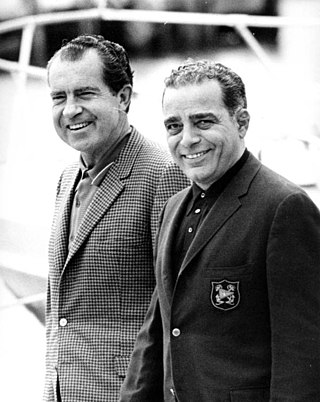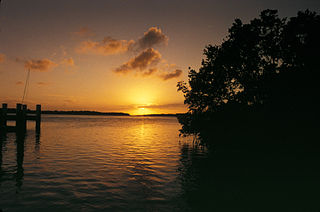
Fisher Island is a census-designated place in Miami-Dade County, Florida, United States, located on a barrier island of the same name. Since 2015, Fisher Island has the highest per capita income of any place in the United States. It is located in the Miami metropolitan area of South Florida. As of the 2020 census, the population was 561.

Key Biscayne is an island village in Miami-Dade County, Florida, United States. The village is part of the Miami metropolitan area of South Florida. The population was 14,809 at the 2020 census, up from 12,344 in 2010.

Coconut Grove, also known colloquially as The Grove, is an affluent and the oldest continuously inhabited neighborhood of Miami in Miami-Dade County, Florida. The neighborhood is roughly bounded by North Prospect Drive to the south, LeJeune Road to the west, South Dixie Highway and Rickenbacker Causeway to the north, and Biscayne Bay to the east. It is south of the neighborhoods of Brickell and The Roads and east of Coral Gables. The neighborhood's name has been sometimes spelled "Cocoanut Grove" but the definitive spelling "Coconut Grove" was established when the city was incorporated in 1919.

Biscayne National Park is an American national park located south of Miami, Florida in Miami-Dade County. The park preserves Biscayne Bay and its offshore barrier reefs. Ninety-five percent of the park is water, and the shore of the bay is the location of an extensive mangrove forest. The park covers 172,971 acres and includes Elliott Key, the park's largest island and northernmost of the true Florida Keys, formed from fossilized coral reef. The islands farther north in the park are transitional islands of coral and sand. The offshore portion of the park includes the northernmost region of the Florida Reef, one of the largest coral reefs in the world.

Biscayne Bay is a lagoon with characteristics of an estuary located on the Atlantic coast of South Florida. The northern end of the lagoon is surrounded by the densely developed heart of the Miami metropolitan area while the southern end is largely undeveloped with a large portion of the lagoon included in Biscayne National Park.

Key Biscayne is an island located in Miami-Dade County, Florida, located between the Atlantic Ocean and Biscayne Bay. It is the southernmost of the barrier islands along the Atlantic coast of Florida, and lies south of Miami Beach and southeast of Miami. The key is connected to Miami via the Rickenbacker Causeway, originally built in 1947.

Dante Bruno Fascell was an American politician who represented Florida as a member of the United States House of Representatives from 1955 to 1993. He served as chairman of the House Foreign Affairs Committee for nine years.

Virginia Key is an 863-acre (3.49 km2) barrier island in Miami, Florida. It is located in Biscayne Bay south of Brickell and north of Key Biscayne and is accessible from the mainland via the Rickenbacker Causeway.

Charles Gregory "Bebe" Rebozo was an American Florida-based banker and businessman who was a friend and confidant of President Richard Nixon.

Carl Graham Fisher was an American entrepreneur. He was an important figure in the automotive industry, highway construction, and real estate development.

Robert Henry Abplanalp, (KHS) was an American inventor and engineer who invented the modern form of the aerosol spray valve, the founder of Precision Valve Corporation, a Republican political activist, and a close confidant of Richard Nixon.

Elliott Key is the northernmost of the true Florida Keys, and the largest key north of Key Largo. It is located entirely within Biscayne National Park, in Miami-Dade County, Florida, east of Homestead, Florida. It is bordered by the Atlantic Ocean to the east, Biscayne Bay to the west, Sands Key to the north, and Old Rhodes Key to the south. Adams Key is just west of the southern end of Elliott Key. Elliott Key is about seven miles (11 km) long. Its maximum width is about 2,500 feet (760 m) near the north end, and its average width is less than 2,000 feet (610 m). The higher elevations on the island range from 6 to 8 feet above sea level and occur generally along an unimproved road that runs longitudinally through the center of the island. The average elevation is about 3 feet (0.91 m) above sea level. The key is accessible only by boat. Elliott Key has a National Park Service campground, but is otherwise uninhabited.

The Cape Florida Light is a lighthouse on Cape Florida at the south end of Key Biscayne in Miami-Dade County, Florida. Constructed in 1825, it guided mariners off the Florida Reef, which starts near Key Biscayne and extends southward a few miles offshore of the Florida Keys. It was operated by staff, with interruptions, until 1878, when it was replaced by the Fowey Rocks lighthouse. The lighthouse was put back into use in 1978 by the U.S. Coast Guard to mark the Florida Channel, the deepest natural channel into Biscayne Bay. They decommissioned it in 1990.
The Florida White House was an informal name for a compound in Key Biscayne, Florida, used by U.S. President Richard Nixon.

The Barnacle Historic State Park is a 5-acre (2.0 ha) Florida State Park in the Coconut Grove neighborhood of Miami, Florida at 3485 Main Highway.
Rosie, an Asian elephant, was an instrumental figure in the history of the U.S. city of Miami Beach, Florida. Her appearance in publicity photos helped to contribute to the area's early reputation for being a place that a visitor had to see to believe.

The Half Moon was a racing sailboat; it sank in 1930 near Miami, Florida, United States. The wreck is outside Bear Cut, which separates Virginia Key from Key Biscayne. Christened Germania, the racing yacht featured a chrome-nickel steel hull built by Krupp-Germania-Werft in 1908 in Kiel, Germany. During a visit to England in 1914, the yacht was seized as a 'war prize'. After changing owners several times, and surviving an especially-violent storm off Virginia, the yacht became a floating restaurant and dance hall off Miami. It sank near Key Biscayne in 1930. In 2000, the wreck became the seventh Florida Underwater Archaeological Preserve. In 2001, it was added to the US National Register of Historic Places.

Adams Key is an island at the northern part of the upper Florida Keys in Biscayne National Park. It is in Miami-Dade County, Florida. It is located west of the southern tip of Elliott Key, on the north side of Caesar Creek in the lower part of Biscayne Bay. The key is only accessible by boat, and overnight docking is prohibited.

Stiltsville is a group of wood stilt houses located one mile south of Cape Florida, on sand banks of the Safety Valve on the edge of Biscayne Bay in Miami-Dade County, Florida. The structures stand on wood or reinforced concrete pilings, generally ten feet above the shallow water, which varies from one to three feet deep at low tide.

The Long Key Bridge, officially known as the Dante B. Fascell Bridge, is a bridge in the Florida Keys connecting Long Key and Conch Key, roughly halfway between Miami and Key West. At a length of nearly two and a half miles, it is the second longest bridge on the Overseas Highway after the Seven Mile Bridge. The current bridge opened in 1982, replacing the parallel Long Key Viaduct, which carried the Overseas Railroad from 1907 to 1935 and was repurposed for highway use shortly after.


















